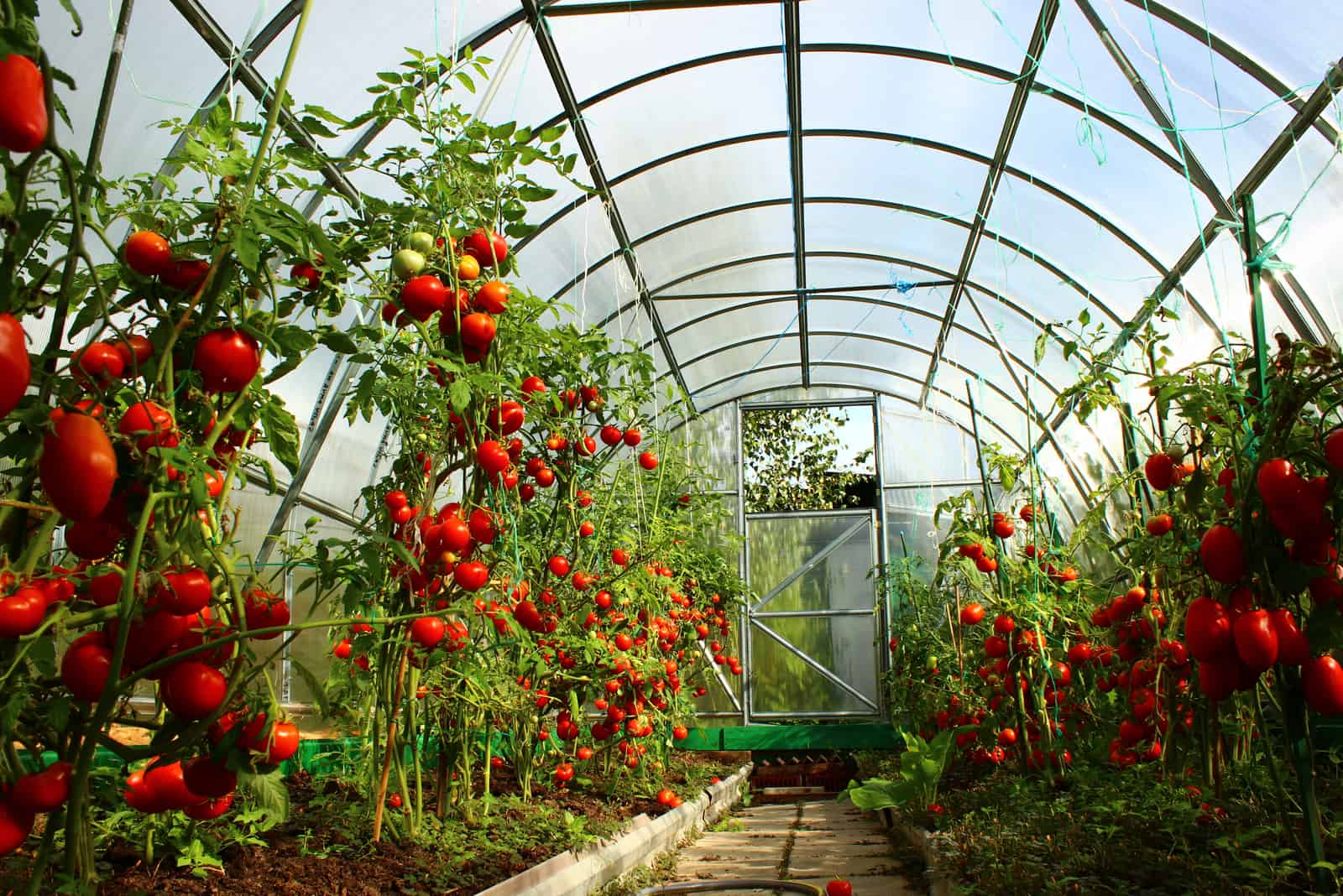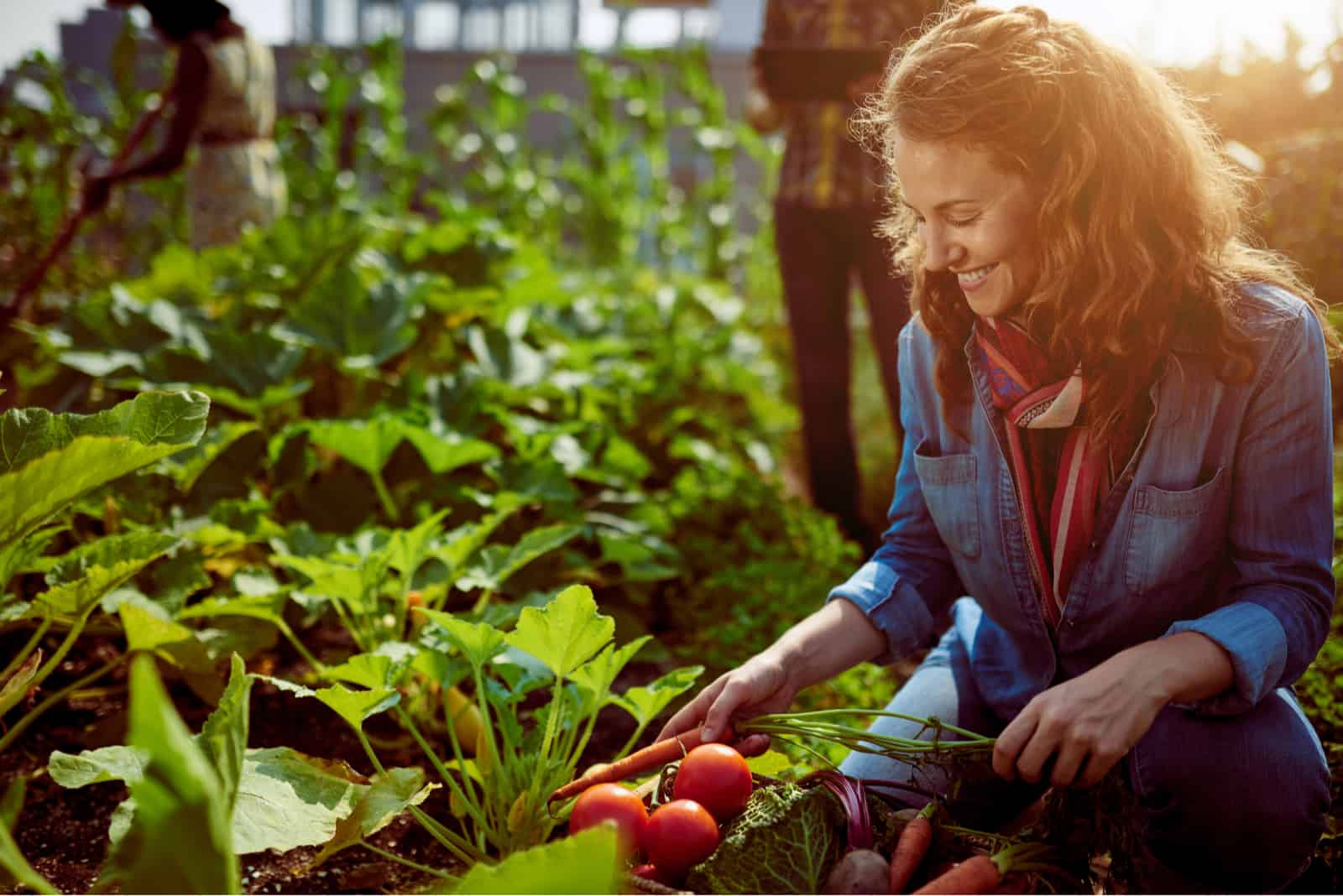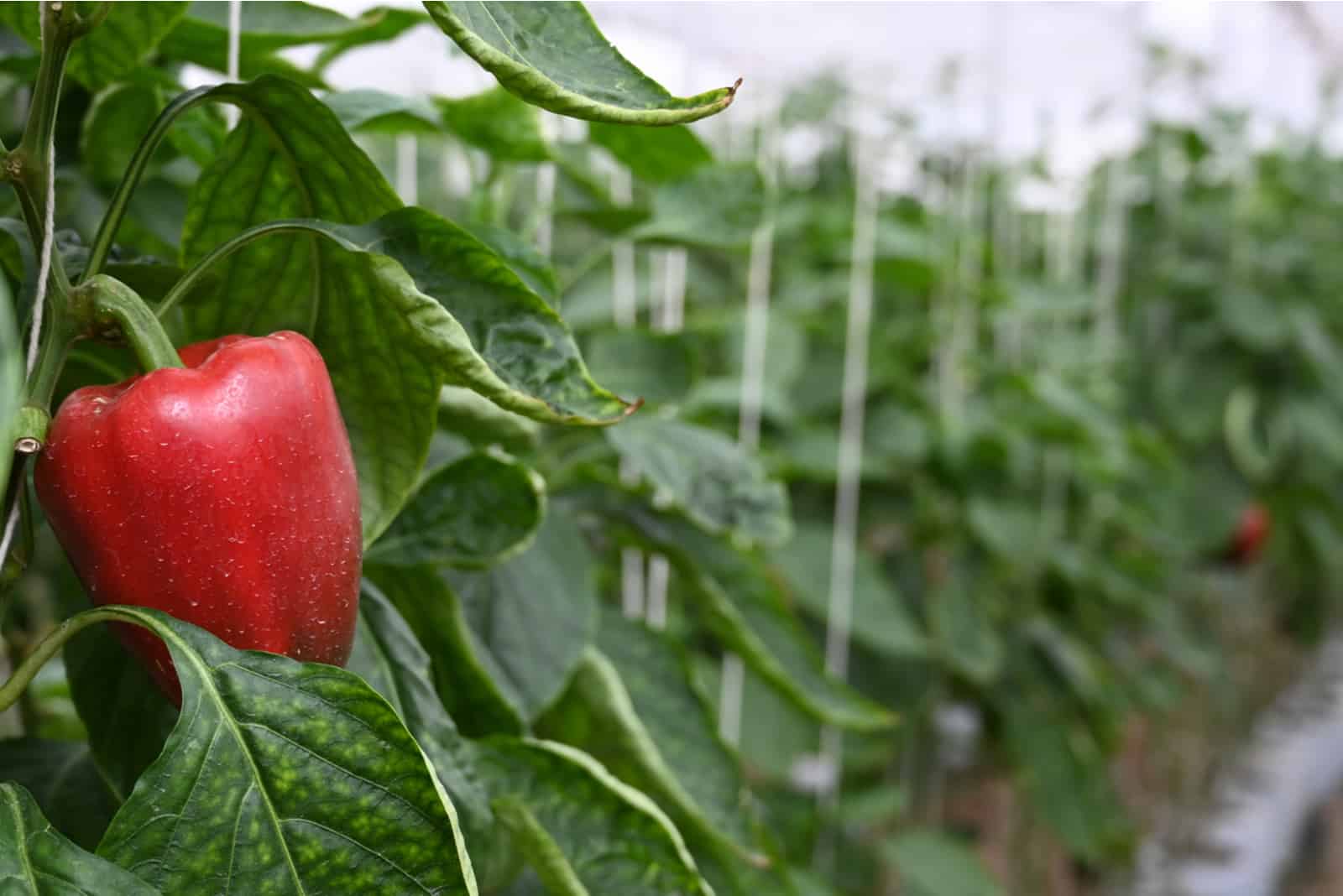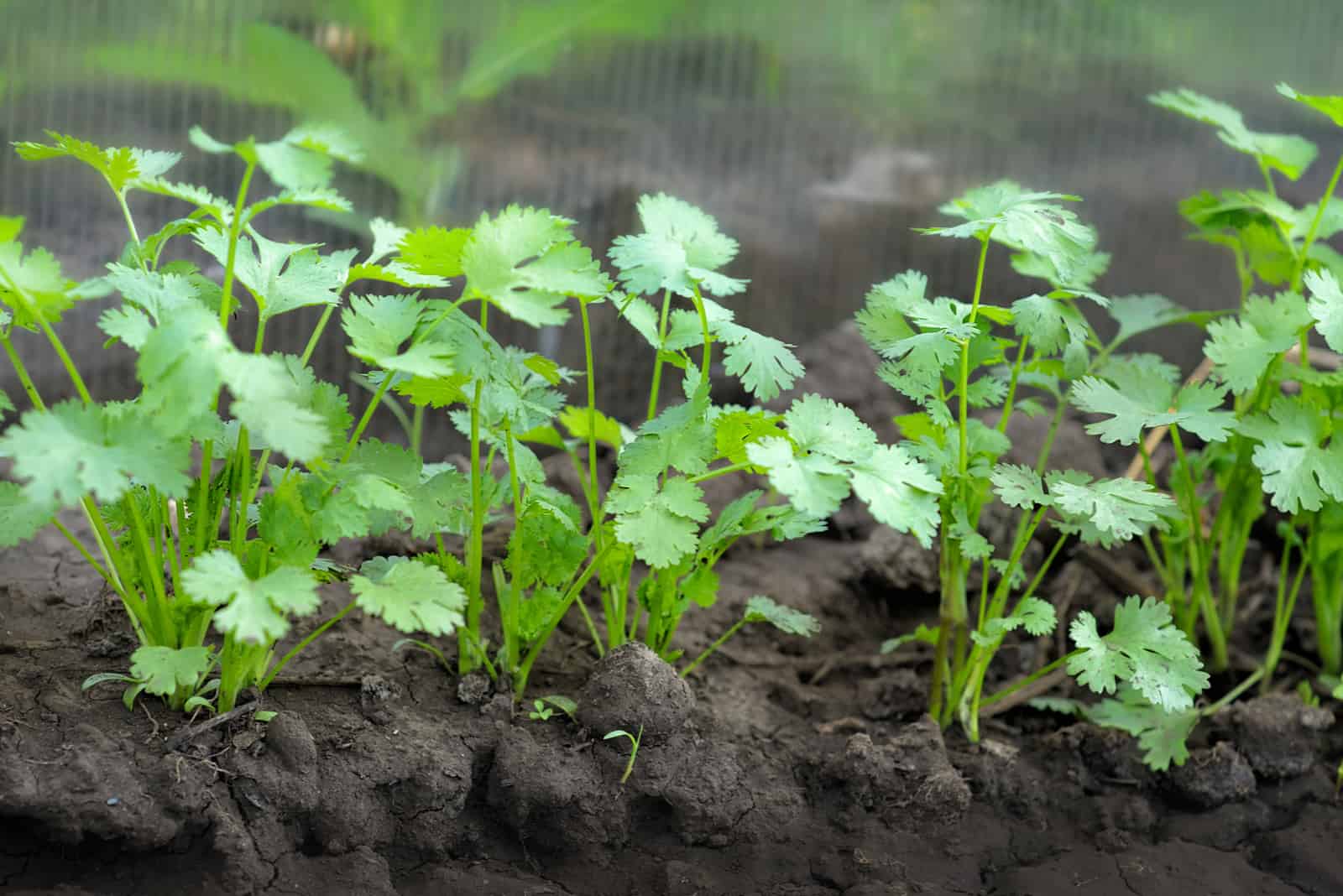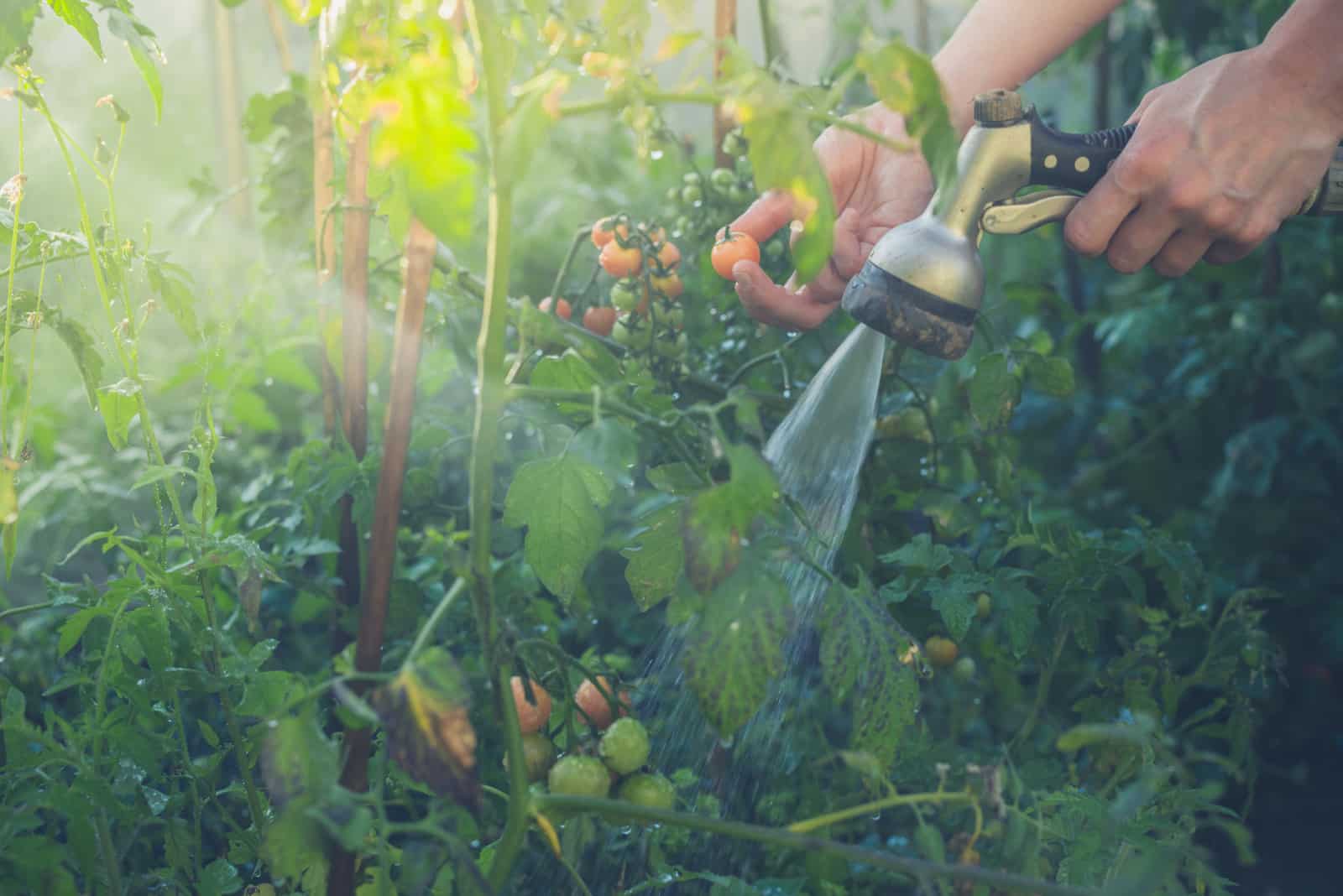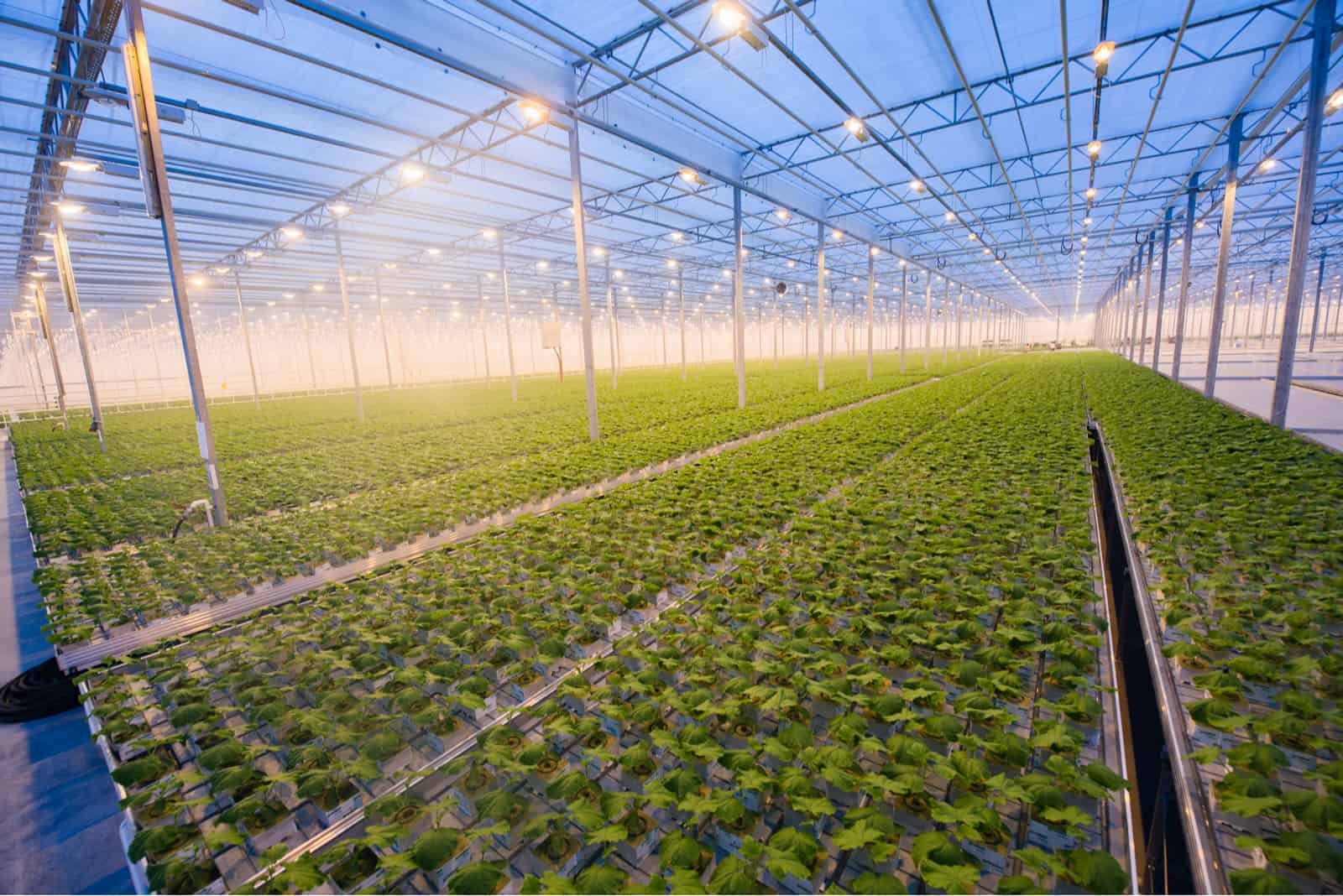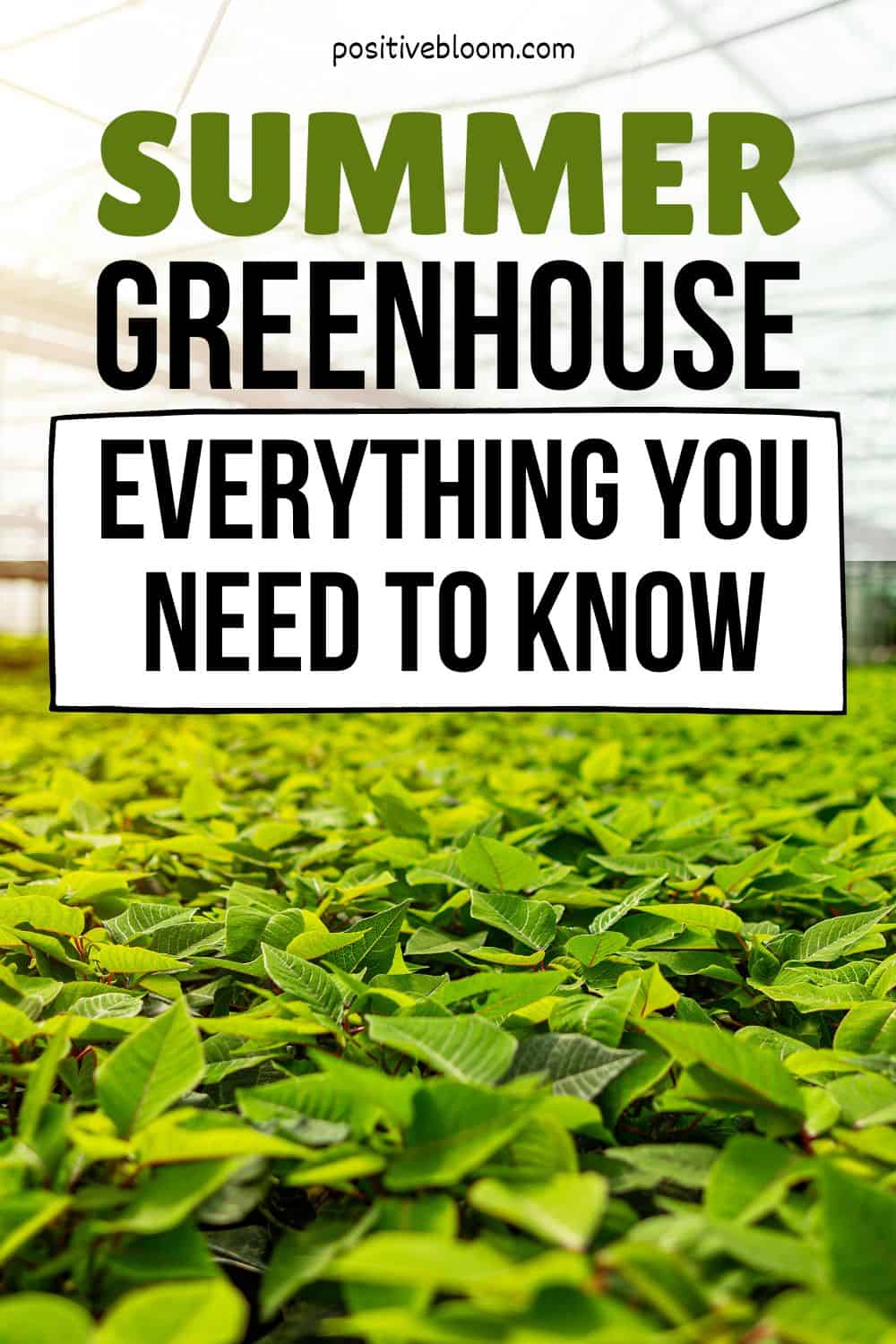Greenhouse gardening is a great way to get out of season plants. You can also get fresh crops that you may not be able to find in stores.
I am a big fan of greenhouses for many reasons, the main one being that I don’t have to worry about little animals stealing my precious crops!
A greenhouse is mainly used to provide warm temperatures for plants.
So, what do you do with your greenhouse in summer? It’s an entirely valid question. Hot summers create a perfect environment for outdoor growing, so maybe there’s no need for a greenhouse at all!
However, a summer greenhouse has its benefits. Any heat-loving plants you have will grow nicely in a greenhouse during the summer. Seeds need higher temperatures to germinate, which is another handy benefit..
There are plants that thrive in greenhouses in summer due to the increased humidity, but you must also provide good air circulation.
I wrote this article to show you how you can use a greenhouse in summer, the plants to grow in it, and how to improve or adjust the conditions to your plants’ needs.
Let’s get started!
Ways To Use A Summer Greenhouse
The words “summer” and “greenhouse” make us think of high temperatures, and they are often used differently in the other seasons.
Plant growers always try to make the best out of any situation, so they don’t want to leave their greenhouses empty during the summer months.
My greenhouse is full of veggies, herbs, fruits, and even flowers in every season. As an expert in horticulture, I can tell you that if you adjust the conditions in your greenhouse, you can get better crops than in your outdoor garden!
Let’s look at some ways to use a greenhouse in summer!
Summer Crops
There are several ways to regulate the temperature in a greenhouse, which we’ll discuss later in the article, so be sure to keep reading.
Some veggies prefer heat, and temperature fluctuations may damage them, so growing them in a greenhouse is a good option.
If you are looking for a sunny and warm spot in your garden to plant some vegetables like cucumbers or eggplants, feel free to move them to the greenhouse. It will save some space in your garden for plants that aren’t big fans of heat.
When you purchase a greenhouse, it’s a long-term investment, so you should always use it during summer; some veggies will really appreciate it!
Seed Germination
It’s important for beginner greenhouse growers to know that they should prepare their plants for the second growing season in a greenhouse.
If you want to grow plants year-round, you need to get the plants started early in late summer or early fall.
This is because the days are still long and the seeds will receive more bright indirect light, which will help them to germinate.
Any seedlings that don’t receive enough light may become leggy, so planting them in late summer in a greenhouse is the best thing you can do. You can also use some grow lights if you’re unsure about light conditions.
You can use germination trays for seed starting or sow the seeds directly in the soil.
How long it takes for germination depends on the climate and design of your greenhouse.
Year-Round Greenhouse Growing
If you live in an area where the temperatures may go over 100 degrees Fahrenheit, growing in a greenhouse during summer is the only way to get crops.
Proper air circulation and a good ventilation system are required for successful growth.
If you invest in a good and energy efficient greenhouse, you can grow a lot of crops during summer.
You should also consider investing in a cooler to protect the greenhouse from overheating.
I suggest planting flowers near your greenhouse during summer to attract pollinators like ladybugs and bees.
Plants To Grow In A Summer Greenhouse
Although you can grow almost any plant in a greenhouse, I suggest you choose heat-loving plants that produce a lot of crops. There are plenty of vegetables that thrive in greenhouses, so I’m sure you won’t have trouble finding some.
However, if you decide to grow beets, potatoes, or carrots, I suggest you plant them in your outdoor garden as they’ll do just fine there. If you grow vining plants, bear in mind that you’ll need a trellis to support them.
Let’s see the plants that thrive in a summer greenhouse!
Peppers
If you want to grow peppers in your greenhouse, I suggest you plant them in containers or raised beds.
Peppers thrive in warm climates, so sowing the seeds between mid-February and early April is ideal.
Maintain a temperature of 65 to 70 degrees Fahrenheit for optimum germination. I recommend adding compost to the soil to achieve best results.
Peppers require loamy soil that drains well. During the early phases of root formation, these plants don’t require much water because the roots will search deep in the ground for moisture to encourage growth.
Tomato Plants
Tomatoes grow best in warm weather, so keeping temperatures between 70 and 75 degrees Fahrenheit is preferable. Tomato plants require frequent fertilization, which makes compost an excellent choice. To neutralize the compost, you can also add mulch to the soil.
Water them every two days, but make sure the soil is dry beforehand because tomato plants are quite susceptible to overwatering.
A big difference between tomatoes and other vegetables is that you’ll need to use your hands to help with pollination. The wind normally pollinates tomatoes, but you’ll have to do it yourself because there is none in a greenhouse.
Cucumbers
Cucumbers prefer high humidity and frequent watering. Feed them with a fertilizer rich in potassium.
These vegetables have both female and male flowers, and it’s better to remove the male flowers to prevent the crops tasting bitter and becoming overly seedy as a result of pollination.
Melons
Melons appreciate higher temperatures, so anything above 65 degrees Fahrenheit will work well.
These plants thrive in full sun, so growing them in a greenhouse is a great choice.
As long as you keep the soil moist and provide the plant with a fertilizer rich in potassium and phosphorus, it will grow just fine.
Green Onions
Green onions prefer rich, healthy soil with a pH close to neutral and plenty of sunlight.
I suggest you apply mulch as it keeps the soil cool and moist. These are shallow-rooted plants, so they need moisture.
If you grow squash or lettuce in your greenhouse, you can plant green onions in their place the following year.
Herbs
Herbs add a unique flavor to poultry, lamb, and stews. They smell and taste incredible, so if you give them a chance to grow in your greenhouse during summer they’ll pay you back ten fold!
Let’s look at a couple of herbs perfect for greenhouses.
Oregano
This perennial herb is known for its strong flavor and is commonly used in Italian cuisine. Oregano enjoys full sun and will taste even stronger if provided with more sun.
These herbs don’t require much water, so only water them when the soil is dry to the touch.
Pro tip: Water your oregano thoroughly, but less often.
Oregano plants require regular trimming in order to grow bushier. It may seem like too much trimming, but remember that oreganos are self-feeding plants and will quickly grow back.
Parsley
Is there a better herb for soups, sauces, or salad than parsley? I certainly don’t think so! Parsley is a biennial plant native to Mediterranean Europe. However, it’s mainly an annual plant when grown in home gardens.
Parsley needs lots of water, especially during the hot summer months. I suggest adding mulch to keep the soil moist.
Be careful when harvesting; there are ways to harvest parsley without killing it.
Basil
I grow basil to make homemade pesto. It’s so easy and delicious! Basil is known for its strong fragrance, and if you’re planning to make pesto you should grow more plants.
This herb thrives in warm weather and grows best when planted in warm soil. That’s why a greenhouse is a perfect place for it.
These plants need at least 6 hours of full sun a day to grow healthy and thrive.
Basil is an excellent herb to grow in containers or raised beds.
Don’t let the nighttime temperatures drop below 50 degrees Fahrenheit as it can kill the plant.
Dill
Dill is an annual plant, so you should let some of the plants flower and collect the seeds so you can plant them in the following seasons.
Dill is a great companion plant, especially for brussel sprouts, broccoli, and cabbage, as it attracts beneficial pollinators like wasps.
If you want to harvest dill all season long, sow the seeds every few weeks.
Don’t let the plants flower if you want to harvest the leaves throughout the whole season.
How To Cool Off Your Greenhouse In Summer
High greenhouse temperatures are great for growing plants during the winter months. You may be wondering what to do with your greenhouse during the summer as the hot weather increases the temperatures.
The answer is to cool off your greenhouse.
Let’s learn a couple of ways to keep a greenhouse cool during the summer.
Ensure It Has A Good Ventilation System
Providing plants with good airflow is one of the most effective ways to fight the heat. Roof vents, side vents (typically louvered), and the greenhouse door can all help to provide the necessary air circulation to cool down overheated plants.
A roof vent area equal to one-fifth of the floor will give a complete air change every two minutes. In most greenhouses, this percentage of roof vents is pretty impossible to afford, but by opening side vents and doors you can let cool air inside.
An essential for any greenhouse is a thermometer. The temperatures that can damage your plants are above 81 degrees Fahrenheit.
I know it can be hard, but you’ll need to get up as early as possible to open the doors and vents. Don’t close them when the nights are warmer than usual.
If you’re wondering how to protect your plants from cats or wildlife, placing netting on the doors and windows may be the best you can do. However, make sure that pollinators and other beneficial insects can get through the netting. It won’t repel smaller insects like whiteflies, but will do great with ladybugs and bees.
You can consider getting automatic vent openers, but always check it’s working because even one night can cause severe damage to your plants!
Shade Your Greenhouse
Another great thing you can do to protect your greenhouse from overheating is shading it. However, you must be careful with this method as your plants need light to grow healthy.
You can filter sunlight by using shade paints. Luckily, they are affordable and work instantly. The great thing about shade paints is that you can add layers as the heat increases. When the temperatures start dropping at the end of the summer, simply wash and brush them off.
Some greenhouses come with unpainted timber if netting and shade cloth are already installed. On the other hand, some greenhouses have polycarbonate pads that can raise temperatures within the greenhouse, so additional shade clothing may be needed.
There are two types of shade cloth, internal and external.
Internal vs External Shade Cloths
An external shade cloth filters the sunlight before it’s trapped inside your greenhouse as it passes through the glass. The good thing is that you can remove them as the temperature drops.
An external shade cloth is way more effective than an internal one, but it has some drawbacks. It can affect greenhouse ventilation, so consider adding devices to promote airflow.
Bad weather or sun may destroy them, so they aren’t long-lasting like the internal ones.
External shade cloths don’t look great, but as long as they create a good environment for our plants, they are a nice choice.
On the other hand, an internal shade cloth with automatic vent openers is an expensive method of shading a greenhouse. However, they conserve energy way better than external, are long-lasting, and look great.
They filter the sunlight, but may not decrease the temperature in your greenhouse, so I recommend external shade cloths.
Keep Your Plants Watered
Plants need enough soil moisture for their roots to grow healthy and send nutrients to the other parts of the plant.
This is why it’s important to never skip watering.
Transpiration is the loss of moisture through the stomata (leaf pores), and is the most effective way for plants to stay cool. This loss of moisture cools the leaf surface in the same manner that sweating does for people.
When plants aren’t able to transpire they can become overheated and wilt. By allowing the plants to draw up adequate moisture from below, they will remain stress-free.
If you’re unsure if your plants need water, here are some sure signs they are thirsty:
• Scorched leaves
• Young leaves drying out
• Plant or leaves wilting
• Brown leaf edges or tips
If you grow plants like succulents in your garden, remember that they are susceptible to overwatering, so try to avoid that too.
Wet And Hard Surfaces
Damping down or wetting hard surfaces is a DIY method and another great way to cool off your greenhouse in summer.
Wetting paths is beneficial as it raises humidity within the greenhouse.
How does it work?
Water evaporates and the air moisture level increases, which protects your plants from overheating.
Additionally, high moisture will deter pests that prefer dry air, such as red spider mites.
I know you can’t spend the entire day standing with a hose and wetting your paths, but wetting in the early morning or evening can really do wonders.
Evaporative Cooling
Evaporative cooling is an affordable, long-lasting, eco-friendly, and effective way to cool your greenhouse in summer!
Evaporative coolers draw in warm air and use pads to cool down the greenhouse.
You’ll need to choose an appropriate evaporative cooler for your particular greenhouse. To cool 20 square feet of floor area, you’ll need around 1 square foot of pad. Furthermore, cleaning your evaporative systems on a regular basis will significantly improve their efficiency.
Greenhouse Fans
Moving air around your greenhouse will help cool it down a bit, however, it will continue to use air from the inside or outside. So, if the temperature outside is about 90 degrees Fahrenheit, don’t expect your greenhouse to cool much below that if you are solely using an exhaust fan to cool it.
When it comes to fan systems, there are various alternatives. However, there are a few things to think about before installing a fan cooling system.
To begin, determine the ideal fan size for your greenhouse. You’ll need to figure out what ventilation rate is best for your structure. You could hire an expert to assist you with this.
Now choose the location for your fan. The top of the structure works best as hot air moves up so the airflow is above the greenhouse plants.
Evaporative cooling is a better option if you live in an extremely hot climate.
Portable Air Conditioner
Another great solution for cooling large greenhouses is a portable air conditioner, and the majority of them include a dehumidifier.
They’ll assist in keeping your greenhouse cool while also regulating humidity levels.
Unfortunately, air conditioners are fairly expensive, so this choice may not be suitable if you have a tight budget.
Using Plants Strategically
If you are looking for an evaporative cooler, look no further than your garden. Yes, your plants are natural coolers that help with evaporation!
Plants with large leaves are a great way to cool down your greenhouse as the leaves transpire moisture and create shade for the soil.
Now that we know the best climate control options, let’s find out why growing plants in a greenhouse is such a great idea!
The Benefits Of A Summer Greenhouse
You’ll undoubtedly benefit by growing plants in your greenhouse. You may need heaters during winter or coolers during summer, but it’s definitely worth it.
Let’s see the biggest benefits of greenhouses.
Pest Prevention
Pests are the worst nightmare of all plant growers, and they’ll use anything to repel them.
You won’t have to worry about pests if you grow plants in your greenhouse during summer.
Some pests thrive in humid areas, so the dry air in your greenhouse won’t be suitable for them. It may even kill them.
Pests like red spider mites and swarms won’t want to visit your greenhouse as they’ll have to risk their lives to do so.
Weather Prevention
Many people think that greenhouses are primarily for protecting plants from cold weather during the winter months.
While that is their function during winter, strong winds and heavy rain can occur in summer, so growing plants in the greenhouse during this time will protect them from bad weather.
Additionally, you can filter sunlight using some of the techniques mentioned earlier in the article, while filtering sunlight outdoors may not work.
Increasing Production
I’m sure you already know that plants produce more crops in warmer temperatures. As you can adjust to all other conditions, your plants will thrive and produce more crops.
Greenhouse gardening reduces stress as you aren’t limited to growing plants during only one season. Now that you know using your greenhouse in summer is also beneficial, don’t hesitate and start growing some plants!
FAQs
Do greenhouses get too hot in summer?
Greenhouses do get really hot in summer, and temperatures may go over 90 degrees Fahrenheit. However, there are ways to cool down greenhouses, such as ventilation and cooling systems.
What is the best time of year to use a greenhouse?
The best time to use a greenhouse is in the early spring or late fall, although you can use it all year long. You may need heaters during winter or coolers during summer, but any time of year will be just fine for your plants to thrive if they’re provided with good conditions.
Wrapping Up
A summer greenhouse is a great way to grow heat-loving plants.
Although many growers decide to plant summer crops in their outdoor gardens, growing them in a greenhouse may also give the same results; healthy, thriving plants that produce a lot of crops!
Seeds germinate faster in warmer temperatures, heat deters some pests, and plants produce more crops. All of these are great reasons to use your greenhouse in summer.
There are many ways to cool down a greenhouse during the hot summer. Make sure you pay attention to ventilation, as some methods may affect the airflow in your greenhouse.
I’m sure you’ll enjoy greenhouse gardening during summer as much as I do.
Until next time!
Like this post? Share or pin it for later!

